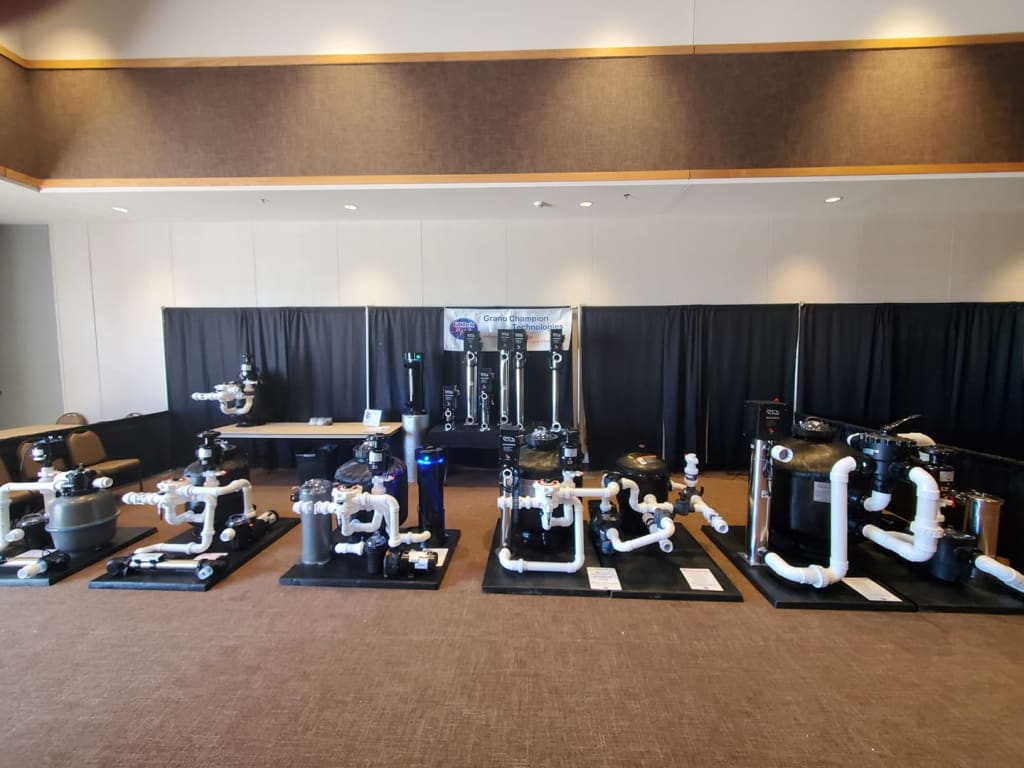Koi Pond Filters Benefit Koi Fish
By GC TEK

Koi pond filters benefit koi by creating an ideal environment for their fish to flourish in. These filters remove contaminants, improve circulation and ensure sufficient oxygen levels in the water.
Biological filtration employs nitrifying bacteria to convert fish waste and uneaten food into less harmful nitrate, producing oxygenated waste water and food as the by-products. Koi pond filters Aeration provides sufficient surface area for this colony of bacteria to grow effectively; hence its essential nature for its success.
Biological Filtration
Koi fish live their entire lives in ponds and like any living thing they produce waste that pollutes and decomposes organic debris that pollutes the water, impacting its health. Koi pond filters help filter out this waste while simultaneously maintaining safe living conditions for your Koi fish.
Koi pond filters must include some form of biological filtration that aids in breaking down organic matter in the pond, through encouraging beneficial bacteria that break down harmful debris and reduce nitrate levels in water quality. This biological filter works through encouraging beneficial bacteria growth which further aid in breaking down organic material while improving water quality by decreasing levels of nitrates in koi pond water quality.
Koi pond filters that use biological filtration also offer another key benefit: reduced algae presence in the water. Bacteria within the filter work to break down and decompose algae blooms so they don't spread across your Koi pond's waters, helping prevent their spread while simultaneously stopping unsightly green weeds from appearing - blocking out sunlight and spoiling its beauty!
If you opt for a koi pond filter with biological filtration, then regular maintenance of its filter is key to its effectiveness. Be sure to follow your manufacturer's guidelines on when this should take place - some filters may even allow water flow through or allow gravity filters' media bed to pass freely over itself and can be cleaned in this manner.

Koi fish require constant oxygen in order to survive; without an air pump to aerate the pond water, your Koi may quickly become sick and die without enough dissolved oxygen in its environment.
There are various aeration systems on the market, but you should aim for one that suits the volume of water in your pond. Some systems rely on electricity while others utilize natural water movement.
Mechanical Filtration
Koi fish require a clean environment in which to sleep, eat, breed and expel waste products. When waste accumulates it can make life more difficult for these aquatic organisms; hence the necessity of an effective koi pond filter system for their wellbeing. There are three primary types of filters; biological, mechanical and chemical. With biological filtering using beneficial bacteria to remove harmful nitrates while mechanical filters physically remove old debris while chemical uses UV lights to kill off any organisms present.
Mechanical Filtration is the initial stage in any pond's filtration system and works to physically filter out dirt, debris and organic materials from the water. This is accomplished using various components like filter brushes, foam pads, screens and sieves which all act together to remove solid waste particles that would otherwise enter biological stages and possibly damage bacteria colonies. Regular mechanical stage cleaning is necessary to keep your system effective.
Biological filtration works by harnessing the natural process of beneficial bacteria to convert ammonia to nitrite, then to nitrate in slow moving waters such as Koi ponds. As this can take quite some time, an efficient Koi pond filter should come into play here; one with multiple benched biological chambers to maximize surface area available to nitrifying bacteria to thrive on is essential.
Bead filters provide high-grade mechanical filtration that captures solid waste particles up to 50 microns in size, creating crystal clear water for your pond. AST's model makes installation straightforward while it doesn't include UV light coverage - perfect if used together with biological filters for the best of both worlds!
Algae Control
Algae can be one of the most dreaded problems in koi enthusiasts' backyard ponds. Not only is it unsightly, but its presence may indicate something is out of balance with your ecosystem.
Luckily there are various methods available for controlling algae; mechanical and biological Koi pond filters is usually effective at this, by filtering out potential harmful organic matter that decomposes into nutrients that feed it back into the water before becoming nutrients for algae bloom.

Pond flocculants can also help combat algae by binding up and sinking it to the bottom of your pond, where it will be easier for biological filters to deal with it. They may be added either as preventive measures or in addition to regular treatments for your pond.
Utilizing plants is another great way to control algae in pond waters. Water lilies and marginal plants offer shade, which reduces sunlight available for photosynthesizing algae. Furthermore, these plants absorb excess nutrients from the pond water which could provide competition against this resource used by algae growth - helping you manage it without harming any koi fish!
Chemical treatments may also help treat severe algae problems; however, these should only be considered as a last resort as they do not address any of the underlying issues that lead to blooms of algae. Many of these chemicals can be toxic for fish so it is crucial that instructions for use are strictly adhered to.
Hydrogen peroxide has proven highly effective at combatting serious pond algae blooms, responding quickly and can be applied spot treatments as necessary. Unfortunately, its use drains oxygen from the water as it destroys the blooms - therefore adding aeration is crucial if using hydrogen peroxide in your pond environment.
String algae is an invasive form of green water algae that often emerges during warmer spring temperatures in pond waterfalls, especially around Koi fish ponds. Many products have proven successful at controlling string algae outbreaks including natural mineral clay calcium bentonite and the AquaScape product EcoBlast which both add minerals to your pond environment while binding up toxins while simultaneously releasing chemicals which inhibit new cell formation and slow the rate of new cell formation.
Water Clarity
Water clarity is of vital importance not only for koi fish but also to the overall health of any pond, as poor quality water can lead to unsightly algae blooms and unpleasant odors, reduced aesthetic appeal and diminished recreation and enjoyment.
Koi are particularly sensitive to these issues so it's wise to monitor water quality and perform partial water changes and cleanings regularly - this can be made simpler using a filter which removes harmful substances and improves clarity in your pond.
First step to creating a high quality water environment is ensuring there is adequate bacteria in your biological filter. These beneficial organisms will eat any waste produced by Koi fish and break it down into less harmful forms like ammonia, nitrites and nitrates - adding them manually or using an automatic dosing unit will do just fine!

After installing your mechanical Koi pond filters, it is necessary to regularly maintain it to remove waste collected by it. In summertime this should be done once every week while for spring and autumn it should be once every fortnight. A special filter cleaning media that doesn't harm bacteria should be used; many products feature this capability already.
Your pond must also be aerated to provide enough oxygen for its bacteria. Nitrifying bacteria require oxygen for proper functioning; otherwise they'll die if the water in your pond becomes stagnant. Installing an air pump into your pond is an excellent way of increasing oxygen levels in its contents.
Final Step: Monitoring Ammonia, Nitrites, Nitrates and pH. Doing this regularly allows you to quickly identify any problems with the water quickly and make any needed changes quickly. Ideally ammonia levels should remain below 1ppm while nitrite levels should remain between 5-6ppm; pH levels should fall in between 7.0-8.5 range.
About the Creator
Aqua Bead | GCTek
Discover a wide range of cutting-edge products at GCTek. From the revolutionary AlphaNANO and AlphaONE filters to the high-performance AquaBead & BioMotion filters, we offer a comprehensive selection to meet all your water filtration needs.






Comments
There are no comments for this story
Be the first to respond and start the conversation.